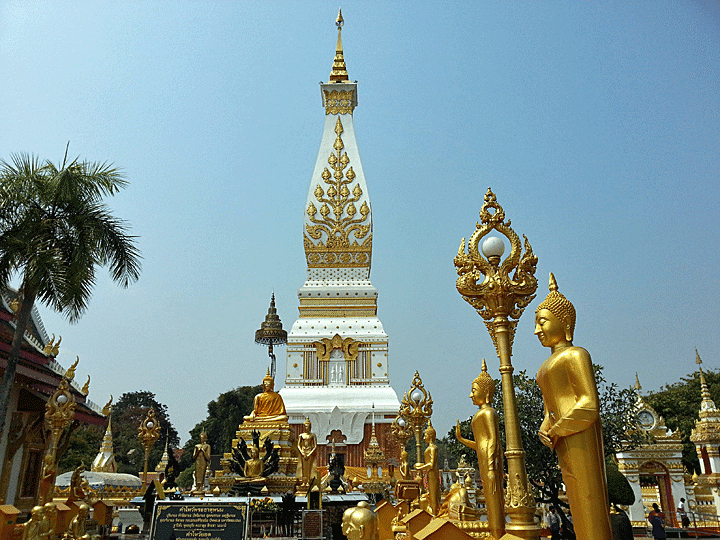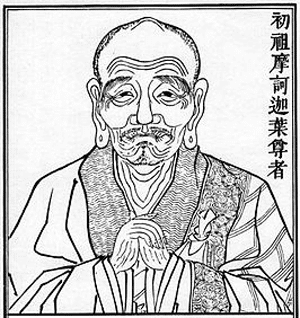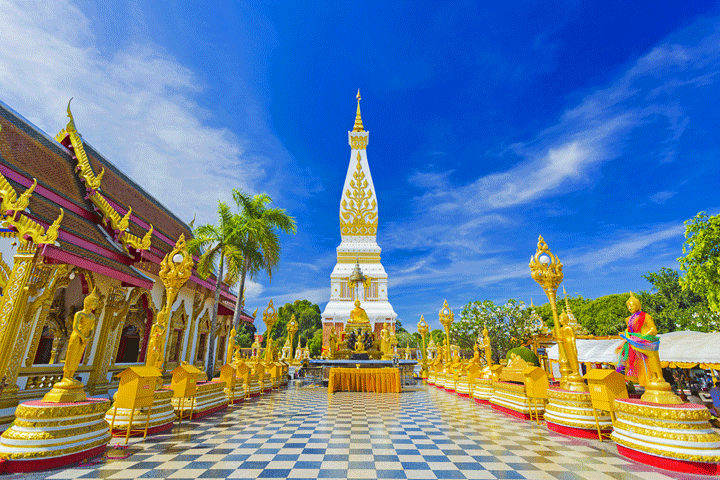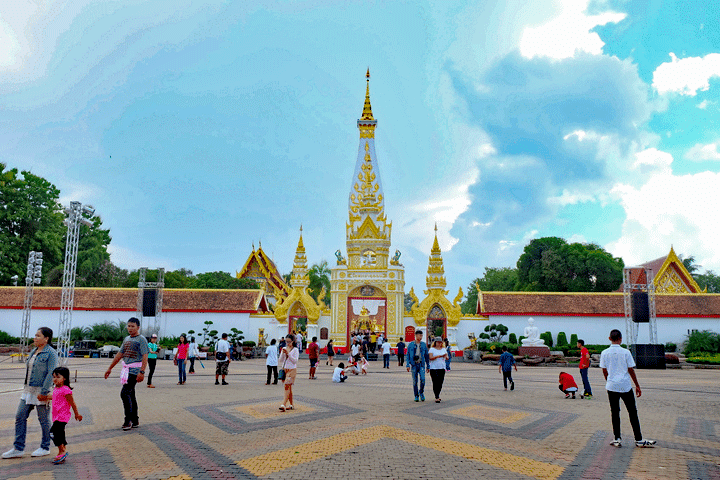Wat Phra That Phanom: Pearl of the Mekong Valley

Before you know it you've already driven through it: The somewhat sleepy town Nakhon Phanom looks unsightly now but it was once the center of the mythical principality of Sri Kotrabun that of the 5e to the 10e century of our era asserted its authority along both banks of the Mekong. The most important relic that can be found in the area from this glorious period is without a doubt the Temple Wat phra that phanom.
Although this temple is located in a remote corner of the country, it is high on my personal list of the most interesting sights in the Land of Smiles. And rightly so because this is one of the oldest and most revered Buddhist sites in the world Isaan and Thailand. I have now had the opportunity to visit Wat Phra That Phanom twice and have not regretted it for a second. Surrounded by legends and shrouded in a haze of mysticism, a visit to this site is always a special experience. Walking here on a weekday among monks and pilgrims reciting in a haze of incense, you soon realize how deep-rooted the worship is in this complex and how firmly this temple is anchored in the social fabric of the Northeast. The 57 meter high chedi, encrusted with precious stones and gold leaf, in the form of a slender, stylized lotus bud, reaches towards the clear blue sky like a stone-turned finger pointing to Nirvana.

Mahakasyapa
According to legend, Mahakasyapa, a Brahmin who became one of the first and most important disciples of Gautama Buddha, at the latter's request, eight years after his death, brought his sternum to the banks of the Mekong and to the place where That Phanom would later arise , together with 500 enlightened spirits and local leaders have built a shrine for this precious relic. The story of the construction can be found on the, perhaps from the 10e century, stone panels at the base of the chedi. However, do not get too close to the base of this shrine as this area is exclusively reserved for monks.
The original chedi, which was probably about eight meters high, was probably built on an artificial mound and was made of bricks baked from the clay of the Mekong. In any case, archaeological research has shown that the temple complex that was built around this chedi was probably between 7 and XNUMX years old.e in 9. e century of our era was built. But it was already a place of worship and meditation before this period.
It is certainly no coincidence that the chedi is described as Laotian in architectural style in most travel guides. In the 16e century, the complex was considerably expanded by the Laotian king Setthathirath (1534-1571), ruler of Lang Xang and ruler of Lanna. It was this king who raised the chedi to 47 meters. Shortly after the turn of the twentieth century, the temple was, to put it mildly, in a bad state. The roots of banyan trees had overgrown much of the site and had damaged the brick structure. Three forest monks Ajahn Sao, Ajhan Mun and Ajhan Tha, who often meditated here, took Phra Khru Virocana, a monk experienced as a master builder, under their arms to save what could be saved. Under his skilful leadership, the decay was stopped and the renovation began, which was crowned in 1941 by the finishing of the chedi, which was raised to its current level.

In August 1975, heavy and abundant rainfall had caused a landslide that severely damaged the temple complex and caused the chedi to largely collapse. Coincidence or not, but a persistent legend told that if the chedi were to disappear, this would also mean the end of the kingdom of Laos. In 1975, the communist Pathet Lao came to power and forced the Lao king Savang Vatthana to abdicate in December of the same year…
Almost immediately it was decided to rebuild and donations poured in from all over the country. The relics were temporarily housed elsewhere while a final, large-scale restoration took place between the late autumn of 1975 and the end of 1979. The skilfully rebuilt chedi was topped with a spire in which no less than 16 kilograms of gold was processed. Wat Phra That Phanom is now one of the country's six 'royal' temples. Together with Wat Phra Phuttabat in Saraburi, it is the only temple of this order of importance outside of Bangkok. The temple has recently become home to another attraction, namely the largest temple gong in the country. This bronze colossus was decorated with all the flags of the Asean countries.

Not only pilgrims from Isaan and the rest of Thailand visit this site, but tens of thousands of pilgrims also come from nearby Laos every year. Thai Buddhists firmly believe that this temple has a special impact on people born in the Year of the Monkey or those who were born on a Sunday. A prosperous and happy life is predicted for believers who have visited the temple on seven separate occasions and walked around the chedi three times after offering sacrifices and prayers.


Definitely worth it, have been there several times because they are Nakhon Phanon's wife.
In the area there is still a lot to visit google it, Laos is also nearby!
Here you will experience the real Thailand. Very nice town on the Mekong. Wooden houses in the old part with French and Laotian influence. In the evening there is a relaxed atmosphere on the Mekongkade. Good food and some drinks.
An absolute must is the That Phanon Riverview Hotel. Central to the Mekong. Very large rooms. Nice reception. I paid only 2018 THB with breakfast in November 850. Unfortunately no swimming pool, but you need all the time for the temple complex with an extensive garden.
http://www.thatphanomriverviewhotel.com/